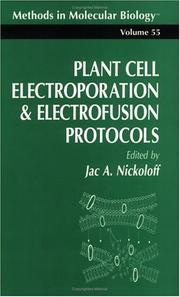| Listing 1 - 3 of 3 |
Sort by
|
Book
ISBN: 0801893143 9780801893148 Year: 2010 Publisher: Baltimore Johns Hopkins press
Abstract | Keywords | Export | Availability | Bookmark
 Loading...
Loading...Choose an application
- Reference Manager
- EndNote
- RefWorks (Direct export to RefWorks)
Crops --- Plant genetic transformation. --- Transgenic plants --- Basic Sciences. Molecular Biology --- Genetic engineering --- Environmental aspects. --- Germplasm resources. --- Risk assessment. --- Genetic Engineering. --- Plant genetic transformation --- Risk assessment --- Plant transformation --- Genetic transformation --- Plant genetic engineering --- Germplasm resources, Plant --- Agricultural crops --- Crop plants --- Farm crops --- Industrial crops --- Farm produce --- Plants, Cultivated --- Agronomy --- Crop science --- Plant products --- Genetic engineering&delete& --- Environmental aspects --- Germplasm resources
Book
ISBN: 9780813803494 Year: 2013 Publisher: Ames, Iowa : Wiley-Blackwell,
Abstract | Keywords | Export | Availability | Bookmark
 Loading...
Loading...Choose an application
- Reference Manager
- EndNote
- RefWorks (Direct export to RefWorks)
Transgenic plants --- Plant genetic transformation --- Plantes transgéniques --- Prevention --- GE crops (Genetically engineered crops) --- GE plants (Genetically engineered plants) --- Genetically engineered crops --- Genetically engineered plants --- Genetically modified crops --- Genetically modified plants --- GM crops (Genetically modified crops) --- GM plants (Genetically modified plants) --- Novel crops --- Transgenic crops --- Plants, Cultivated --- Transgenic organisms --- Plant genetic engineering --- Plant transformation --- Genetic transformation

ISBN: 0896033287 9786610836642 1280836644 1592595421 1489940804 Year: 1995 Publisher: Totowa (N.J.) : Humana press,
Abstract | Keywords | Export | Availability | Bookmark
 Loading...
Loading...Choose an application
- Reference Manager
- EndNote
- RefWorks (Direct export to RefWorks)
Gene transfer is an essential technology for improving our under standing of gene structure and function. Although there are many meth ods by which DNA may be introduced into cells—including heat and chemical treatments, and microinjection—electroporation has been found to be the most versatile gene transfer technique. Electroporation is effective with a wide variety of cell types, including those that are difficult to transform by other means. For many cell types, electroporation is either the most efficient or the only means known to effect gene transfer. The early and broad success of electric field-medi ated DNA transfer soon prompted researchers to investigate electroporation for transferring other types of molecules into cells, in cluding RNA, enzymes, antibodies, and analytic dyes. The first section of Plant Cell Electroporation and Electrofusion Protocols includes two chapters that serve as a guide to theoretical and practical aspects of electroporation, and will be of particular interest to those developing protocols for as yet untested species or cell types, and a third chapter that describes commercially available electroporation instruments. The remaining chapters describe well-tested protocols for DNA electrotransfection, electroporation of other biomolecules, or cell electrofusion. These chapters also include brief discussions of alterna tives to electric field-based methods, citing the advantages and limita tions of the various methods for achieving specific goals.
Plant genetic engineering --- Plant genetic transformation --- Crops --- Electroporation --- Electrofusion --- Cell Fusion --- Plants --- Genetic Techniques --- Cytological Techniques --- Cell Physiological Processes --- Clinical Laboratory Techniques --- Electrochemical Techniques --- Investigative Techniques --- Eukaryota --- Cell Physiological Phenomena --- Organisms --- Analytical, Diagnostic and Therapeutic Techniques and Equipment --- Phenomena and Processes --- Plant Ecology --- Botany --- Earth & Environmental Sciences --- Laboratory manuals --- Genetic engineering --- Laboratory manuals. --- Bioelectrochemistry --- Cytology --- Membrane fusion --- Agricultural crops --- Crop plants --- Farm crops --- Industrial crops --- Farm produce --- Plants, Cultivated --- Agronomy --- Crop science --- Plant products --- Plant transformation --- Genetic transformation --- Plant biotechnology --- Transgenic plants --- Technique --- Cytology. --- Cell Biology. --- Cell biology --- Cellular biology --- Biology --- Cells --- Cytologists
| Listing 1 - 3 of 3 |
Sort by
|

 Search
Search Feedback
Feedback About UniCat
About UniCat  Help
Help News
News